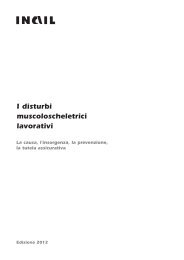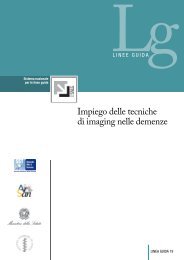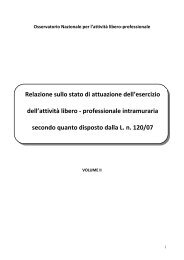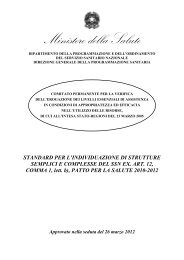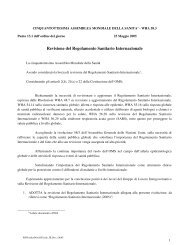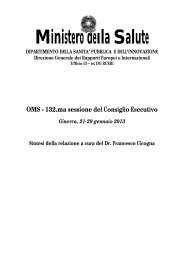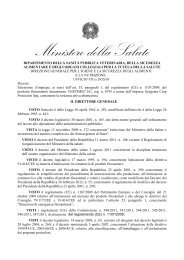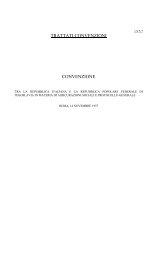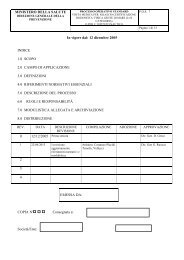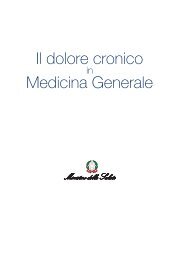hta_ knee intro.qxp - Ministero della Salute
hta_ knee intro.qxp - Ministero della Salute
hta_ knee intro.qxp - Ministero della Salute
Create successful ePaper yourself
Turn your PDF publications into a flip-book with our unique Google optimized e-Paper software.
38<br />
Since the characteristics of patients receiving a prosthesis are unlikely to be homogeneous,<br />
the stratification of performance data per group of patients is important to allow comparisons<br />
across registers. For example, gender, age, and indication for procedure should be reported. As<br />
stated in our previous HTA report on the prostheses for total hip replacement 23 we believe that,<br />
the performance of each <strong>knee</strong> system (clearly identified by system name and manufacturer)<br />
should be expressed with stratification by sex, age groups and indication, to allow a more efficient<br />
analysis. All these variables affect the implant-related outcome 36,37 .<br />
We attempted to overcome heterogeneity of data to compare data-sets from each register. We<br />
corresponded with key persons from the 11 registers identified (reported in Table 7.1) to obtain further<br />
data related to the last published report. Data requests were made by e-mail, <strong>intro</strong>ducing the<br />
Agenas and explaining the HTA report’s objectives. The recipients were informed that the project<br />
was commissioned and financed by the Italian MLHSP. Results are shown in the next paragraph.<br />
7.3.2 Implants performance from arthroplasty registers<br />
Replies obtained from our data requests were various and are synthesised in Table 7.4. We<br />
received all data requested from 3 out of the 11 registers contacted: Australia, Emilia-Romagna,<br />
and New Zealand. We further asked for additional stratification by age (patients aged 50 and<br />
over). Only Australia and Emilia-Romagna sent us the additional data and thus we were forced to<br />
exclude the New Zealand register because of the absence of sufficient age breakdown. This reduced<br />
our sources to 2 registers.<br />
From the data obtained we were able to collect, for each implant model, the following variables:<br />
• Implant name (model name and manufacturer);<br />
• Total number of procedures performed with the implant;<br />
• Percent of females and males who received the implant;<br />
• Mean age (and range) of the population that received the implant;<br />
• Percent of procedures performed for OA;<br />
• Revision rate at 3 and 5 years of follow-up.<br />
These data are presented for Australia (Tables 7.5-7.7), Emilia-Romagna (Table 7.8), and New<br />
Zealand (Table 7.9 and 7.10) respectively.<br />
TKR appeared most commonly performed in females than in males and the rate of OA as primary<br />
indication appeared to be around 90% (this seems verified in all three registers except in<br />
Emilia-Romagna where this seems slightly lower). The mean age for primary TKR was over 60<br />
years for all the three registers. Moreover, the 10 most used <strong>knee</strong> systems cover more than 70%<br />
of the total number of observations in each register and several of these seem to be among the<br />
most frequently used implants in all the registers (for cemented, uncemented and hybrid fixation).



